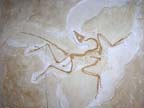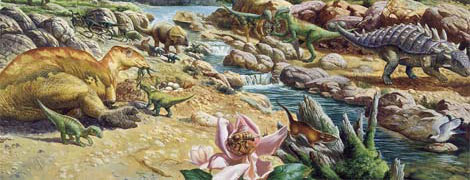 |
 |
 |
 |
 |
Produced
by the Population Genetics and Evolution class, Furman University |
||||
 |
 |
 |
 |
 |
Produced
by the Population Genetics and Evolution class, Furman University |
||||
 |
The
Cretaceous: Iguanodon |
 |
||
| Iguanodon
is the largest, most well known, and most widely found of the iguanodontids
(Encyclopedia Britannica 2010). It was the second dinosaur to be officially
named, after Megalosaurus (Wikipedia 2010). Fossils have been
found In North America, Europe, Asia, Northern Africa, and Australia and
these bone beds have yielded multiple nearly complete skeletons of multiple
species of Iguanodon, along with many other remains (Encyclopedia
Britannica 2010). Iguanodon was 30 feet long, was around 2 meters
at the hip bone, and weighted between four and five tons (Encyclopedia
Britannica 2010). Iguanodon, which means “iguana toothed,”
had teeth that resembled modern day iguana teeth and was also an herbivore
(Dinosaur Isle 2010). What distinguished Iguanodon from many
other dinosaurs was its conical, spike like thumbs that stuck out from
the three main digits that it walked on (Wikipedia 2010). In early reconstructions
of Iguanodon, the spike was placed on the nose; however, as more
specimens were uncovered the misinterpretation was corrected (Encyclopedia
Britannica 2010). The purpose of this spike is still debated, but many
believe it was used to defend itself from predators, or used when foraging
for food (Wikipedia 2010). Iguanodon could shift between walking
on two or four legs, the latter more so as it aged (Wikipedia 2010). It
is questionable that Iguanodon was a herd reptile or not (Wikipedia
2010). There have been many findings of multiple fossilized individuals
in the same location (Encyclopedia Britannica 2010). However in most cases,
these finds are determined to be multiple events and not a single catastrophe
(Wikipedia 2010). Page by Chapin Hardy |
 |
| Iguanodon. Photo From: Wikipedia | |
|
Dinosaur Isle. 2010. Iguanodon. Accessed April 4, 2010. Encyclopedia
Britannica. 2010. Iguanodon. Accessed April 4, Wikipedia. 2010.
Iguanodon. Accessed April 5, 2010. |